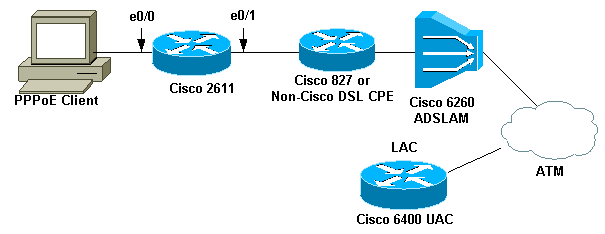The Point-to-Point Protocol over Ethernet (PPPoE) is a network protocol for encapsulating PPP frames inside Ethernet frames. It appeared shortly after the year 2000, in the context of the boom of DSL as the solution for tunneling packets over the DSL connection to the ISP's IP network, and from there to the rest of the Internet. A 2005 networking book noted that "Most DSL providers use PPPoE, which provides authentication, encryption, and compression." Typical use of PPPoE involves leveraging the PPP facilities for authenticating the user with a username and password, predominately via the PAP protocol and less often via CHAP.
On the customer-premises equipment, PPPoE may be implemented either in a unified residential gateway device that handles both DSL modem and IP routing functions or in the case of a simple DSL modem (without routing support), PPPoE may be handled behind it on a separate Ethernet-only router or even directly on a user's computer. (Support for PPPoE is present in most operating systems, ranging from Windows XP, GNU/Linux to Mac OS X.) More recently, some GPON-based (instead of DSL-based) residential gateways also use PPPoE, although the status of PPPoE in the GPON standards is marginal.
PPPoE was developed by UUNET, Redback Networks (now Ericsson) and RouterWare (now Wind River Systems) and is available as an informational RFC 2516.
In the world of DSL, PPPoE was commonly understood to be running on top of ATM (of DSL) as the underlying transport, although no such limitation exists in the PPPoE protocol itself. Other usage scenarios are sometimes distinguished by tacking as a suffix another underlying transport. For example, PPPoEoE, when the transport is Ethernet itself, as in the case of Metro Ethernet networks. (In this notation, the original use of PPPoE would be labeled PPPoEoA, although it should not be confused with PPPoA, which is a different encapsulation protocol.)
PPPoE has been described in some books as a "layer 2.5" protocol, in some rudimentary sense similar to MPLS because it can be used to distinguish different IP flows sharing an Ethernet infrastructure, although the lack of PPPoE switches making routing decision based on PPPoE headers limits applicability in that respect.

